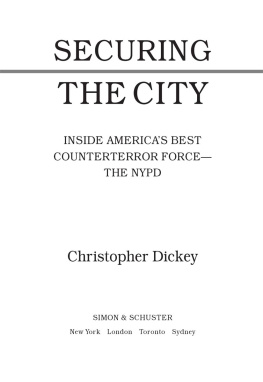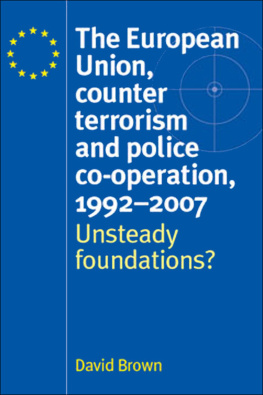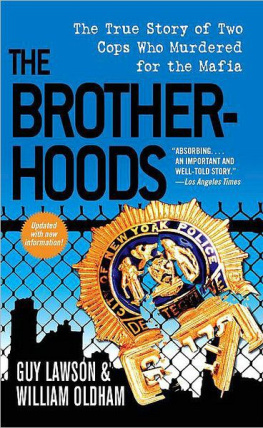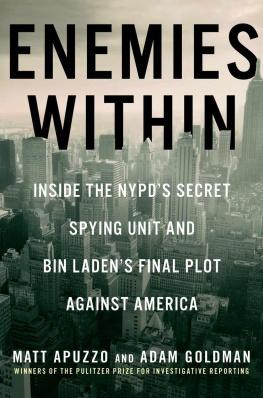All rights reserved, including the right to reproduce this book or portions thereof in any form whatsoever. For information, address Simon & Schuster Subsidiary Rights Department, 1230 Avenue of the Americas, New York, NY 10020.
SIMON & SCHUSTER and colophon are registered trademarks of Simon & Schuster, Inc.
When you catch a terrorist and look at the map in his or her pocket, it is always a map of New York; its not a map of some other place.
PROLOGUE
The winter air is cold and the light hard-edged as the unmarked New York City Police Department helicopter meanders through the winds above the five boroughs. The morning is clear in a wayin that waythat is always a little heartbreaking if you were here on September 11, 2001. There were police choppers in the New York sky then, too, but not like this one, which can see so much from so far. It is a state-of-the-art crime-fighting, terror-busting, order-keeping techno toy, with its enormous lens that can magnify any scene on the streets almost one thousand times, then double that digitally; that can watch a crime in progress from miles away, can look in windows, can sense the body heat of people on rooftops or running along sidewalks, can track beepers slipped under cars, can do so very many things that the man in the helmet watching the screens and moving the images with the joystick in his lap, NYPD Detective David Zschau, is often a little bit at a loss for words. It really is an amazing tool, he keeps saying. On the left-hand screen is a map of Manhattan. He punches in an address on the Upper East Side, my address. The camera on the belly of the machine swivels instantaneously, focuses, and there on the second screen is my building seen from more than a mile way now, but also up close and personal from this surprising astral angle. The cameras and sensors are locked on to it, staying with it as the chopper turns and homes in.
I am glad that I am up here looking, and not down there looked at unknowingly. There is always an uneasy tension between the right to security and the right to privacy and this morning I can feel it, can see it in bold relief as we fly only a few hundred feet above the citys highways and avenues, parks and alleys, museums, monuments, skyscrapers, train stations, hotels, stores, stadiums, stock markets, churches, synagogues, mosques, schools, and homesall those homes. A city is not an abstraction like homeland, it is home, full stop, to millions of people. And if you live here, and are part of it, what would you be willing to do to defend it? What wouldnt you be willing to do? New York City is the most target-rich environment for terrorists imaginable, a dense metropolis waiting to be ground zero. Yet from this height it seems so peaceful. And this morning in January 2007 it is, and for the rest of this year it will be.
How is that possible? What does it take to make a city safe in the twenty-first century? And what, in particular, does it take to secure this city, which was for so many generations a maelstrom of crime and always an inviting target for mass destruction? Thirty years ago, the placid cityscape beneath us was written off as an urban wasteland, bankrupt financially and morally. A blackout on a single summer night in 1977 brought on riots and led to three thousand arrests. By the 1980s, the homicide toll had soared and paranoia with it. People were killing one another at the rate of six a day; babies were taking stray bullets; all strangers were suspect. The city seemed out of control, a cloaca pulsing with chaos and dangerand it was.
The rest of the country turned its back on Gotham, writing it off in a long series of grim caricatures. In 1970, country singer Buck Owens thrummed a nationwide hit with the refrain, I wouldnt live in New York City if they gave me the whole dang town. A steady stream of police films showed the sleazy underside of the urban world The French Connection, Serpico, Dog Day Afternoon, Fort Apache: The Bronx until by 1981, Hollywood director John Carpenter was imagining Manhattan as one vast prison island in Escape from New York. When President Gerald Ford said he wouldnt cough up the federal funds to ease its deepening financial crisis in October 1975, the Daily News ran the iconic headline: Ford to City: Drop Dead.
But more than thirty years later, there the city was beneath the lenses and sensors of the police chopper, which showed it very much alive: a city of survivors, and then some. Above Ground Zero the lacuna left by the World Trade Center loomed, an aching emptiness that anyone could see. But only those who had been immersed for years in the annals of terror would notice the other places on the grid where saboteurs and mass murderers had struck the city. In July 1916, on a spit of New Jersey land that juts into New York Harbor, German saboteurs blew up a munitions dump and created a blast so powerful it sent shrapnel into the Statue of Liberty, shattered windows throughout Manhattan, and rumbled like distant thunder hundreds of miles away. In September 1920, a huge bomb in a horse-drawn cart exploded in front of the J.P. Morgan building at 23 Wall Street, killing thirty-three people and injuring hundreds. The scars it left in the stone are still visible. In the 1940s and early 1950s, Mad Bomber George Metesky, a disabled and disgruntled electrical worker, planted explosives at dozens of vulnerable, high-profile targets, including Radio City Music Hall, the New York Public Library, Penn Station, Grand Central, and several movie theaters.
In the three decades Ive been reporting on guerrilla wars and terrorist conspiracies, the fanatical hatred of countless groups has focused on New York City like a compass needle quivering toward magnetic north. Puerto Ricans and Palestinians, the Japanese Red Army, crazed Islamists and radical Jews, all have schemed to bring terror to the citys streets, and the shock of September 11 did not stop the threat for a second. Theres a plot taking shape on New York City every day of every week since 9/11, NYPD Intelligence chief David Cohen told me when I started the reporting that led to this book. What that plot consists of, whos doing it, and where its percolating from can change, but theres someone out there every day of the week thinking about that.
The job of securing any big city seems at first glance almost impossible; the results obtained in New York almost a miracle. Whats required is an incredibly sensitive equilibrium among disparate and contradictory forces: coercion and finesse, political expediency and public interest; basic cop-on-the-beat police work and sophisticated intelligence gathering; respect for the law but a willingness to bend rules; ostentatious spectacle and secret surveillance; lots of police on the street, but maybe a few outside the country; cooperation with federal agencies, but also competition. And, then, theres the matter of personalities like Cohens or that of his boss, Commissioner Raymond Kelly.








